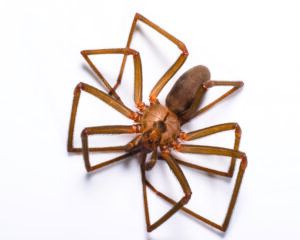All You Need to Know About Spiders
The fact that most spiders are venomous predators doomed them to forever being cast as villains in Hollywood and most everywhere else. However, their bad reputations are largely undeserved and exaggerated, according to Kacie Hargett, a route manager and spider knowledge expert for Sprague Pest Solutions in Portland, Oregon.

While spiders that hunt from webs typically catch adult prey, spiders that hunt from the ground can catch and eat all life stages.
“In all the states where Sprague currently provides service, only one genus of spiders poses any verifiable threat to people,” says Hargett. “Multiple species in the genus Latrodectus, also known as widows, have venom that causes neurological symptoms in people. Still, even widows only bite people as a last resort and in self-defense.”
What other information do commercial property owners/facilities managers need to know about spiders?
Q: Are all spiders bad or are there benefits to their presence?
For some commercial properties, the presence of spiders is advantageous. They work alongside pest control technicians to reduce populations of ants, flies, beetles, moths, and other common pests.
While spiders inside commercial properties such as hospitals or health care facilities are never acceptable, other clients may think twice before trying to eliminate spiders. For example, agricultural yield of many crops can be improved when spiders are present.
Clients should partner with their pest services provider to learn more about the spiders they have at their facilities, and what services that can minimize the negatives of their activity while still maintaining their natural benefits.
Q: What do they eat and where do they live?
With one known vegetarian exception, spiders are carnivores. They primarily eat insects, spiders, and other arthropods, but larger species have also been known to take on frogs, mice, lizards, small possums, and even birds or bats. As a result, they are found where they have an abundance of prey.
Common hunting grounds include natural and artificial light sources, floor drains, leaf litter, and places that are rarely disturbed, such as underneath equipment, furniture or in storage spaces. However, like occasional invaders, they can pop up anywhere in a commercial property.
Sustainable populations have been found everywhere on earth except for the north and south poles. It’s no wonder, since there are more species of jumping spider alone than there are of all described mammals.
Q: What species are most encountered in and around commercial properties?
It is helpful to divide spiders into groups that use webs to hunt, and those that do not. Some of the most common families that hunt from webs include cellar and grass spiders, orb weavers, cobweb weavers, and sheetweb weavers. These are species that sit and wait for prey to come to them. Their presence means that there is enough food in the immediate area to sustain them. It is a good indication to look for active insect infestations, or opportunities to adjust lighting or exclusion practices.
Common families that do not hunt from webs include ground, jumping, wolf, fishing or crab spiders. These families have a reputation for superior intelligence in the arthropod world. While spiders that hunt from webs typically catch adult prey, ones that hunt from the ground can catch and eat all life stages.
Q: What preventive steps can be taken to deter spiders?
The first line of defense against spiders is a well-sealed building. Doors and windows should be closed and sealed when not in use. Missing or ill-fitting window screens and door sweeps are prime opportunities for them to make their way inside.
Controlling the lighting is another defense. If you walk into a building on a sunny day and it takes a minute for your eyes to adjust, it’s more likely that you’ll be able to find spiders in that building.
Eliminating attractants and ideal conditions for prey will in turn reduce the population. Using bio foam in floor drains can reduce drain fly activity, which is a common prey item for cellar spiders. Without the flies to sustain them, they die or move on. Finally, clients can disturb common attachment points for webs. This can be done in conjunction with your pest technician.
Spiders that build webs to hunt require places to attach the silk. Each family builds a different web shape. Orb web weavers might use the corners of windows or doorframes, while cobweb weavers including widows need attachment points above and below them. Cobweb weavers are commonly found underneath furniture, in wood piles, or stored product that is seldom moved.
Some species will recycle their old silk, while others walk away and leave a mess. Frequent de-webbing and web destruction contributes to cleanliness and makes potential habitats less hospitable.
Discover The Sprague Difference
For more information on how Sprague Pest Solutions can assist you establish an effective pest prevention or management program in your commercial property, call 855.805.0755.

